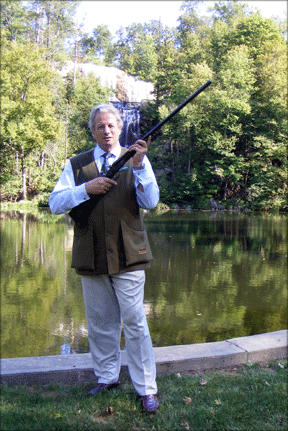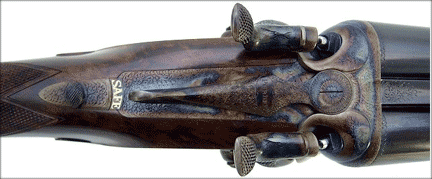The 21st Century Hammer Gun by James Purdey for Griffin & Howe
As with many celebrated turning points in the world of fine shotguns, it all started with a bottle of fine port.
In late September 2000, Mr. Nigel Beaumont, Chairman of English gunmaker, James Purdey & Sons, crossed the Atlantic to attend the Vintage Cup World Side-by-Side Championships at the Orvis Sandanona Shooting Grounds in Millbrook, New York.
The gathering of Edwardian firearms enthusiasts celebrated Purdeys and other pillars of the vintage shotgun pantheon such as L.C. Smith, Parker Brothers, Holland & Holland, and Ithaca Gun Company.
One crisp autumn evening during the event, Mr. Beaumont dined at the home of Mr. Guy Bignell – President and CEO, Griffin & Howe – just a stone’s throw from Sandanona in leafy Dutchess County. As befitting Mr. Bignell’s legendary hospitality, out came the after-dinner port and the arsenal of cigarettes that reckon to measure conversations destined for a long passage into the night.

The stage was now set for an ultimatum put forth in due course by Mr. Beaumont. Mr. Bignell accepted it with the same relish that impels him to race classic Jaguars on the Goodwood circuit near the south coast of England. The arrangement also underscored the influence that Griffin & Howe exerts in the rarified world of luxury firearms.
Mr. Beaumont’s personal challenge was in itself a victory for Mr. Bignell, who for years had encouraged Mr. Beaumont to make a new Purdey hammer gun for the American market. As the port flowed that evening, Mr. Beaumont finally conceded, but under one condition: Griffin & Howe must first procure deposits for 10 of the shotguns. Several months later, Mr. Bignell satisfied his end of the bargain.
“Griffin & Howe reasserted our position in the fine sporting firearms world,” Mr. Bignell explained. “Once again, we pressed, pushed and we were innovative and came up with clients and money to get the whole ball rolling. We thought outside the box when no one else was doing that.”

Underscoring the point of the new hammer gun’s origins, Mr. Beaumont told us over the phone, “The demand was orchestrated by Griffin & Howe. Virtually all of our guns have gone through them because they initially acquired the clients.”
Mr. Bignell’s success in obtaining the requisite hammer-gun deposits demonstrated his deep knowledge of the marketplace for collectible firearms. He regularly takes the pulse of affluent American shotgunners with the skill of a neurosurgeon.
For Mr. Bignell, proximity helps. Griffin & Howe operates showrooms in Connecticut and northern New Jersey, in addition to owning the lavish Hudson Farm shooting grounds also in New Jersey. The Griffin & Howe properties are within easy reach of the Wall Street power brokers who have a flair for bespoke English shotguns and rifles of the highest quality, and you will see many of these clients receive a warm greeting from Mr. Bignell upon their arrival.
This relationship with his patrons became immediately evident during a mid-September weekend last year at the Game Conservancy USA 4th Annual Showcase & Invitational, where I was given the opportunity to actually shoot the new Purdey hammer gun for 100 rounds of sporting clays. The fundraiser for game and habitat conservation in the U.K. is held at Hudson Farm every year and draws on Griffin & Howe’s loyal constituency.
The exhibition, under a regal white tent, also demonstrates Griffin & Howe’s influence among eminent gun makers. The rows of tables displayed extraordinary shotgun masterpieces from the likes of William & Son., Lebeau Courally, Jules Bury, Boss & Co., Holloway & Naughton, Blaser, Charles Boswell, Krieghoff, Perazzi, Arrieta, William Evans, Atkin, Grant & Lang, and Holland & Holland,. And the Purdey hammer gun was in the mix – demurely displayed by Griffin & Howe.

Some seven years earlier, Purdey had initiated work on its new hammer gun. Now its offspring rested on the table-top gun rack and was about to end up in my hands for a morning of shotgun bliss.
Mr. Beaumont said via phone from Audley House in London that the new hammer gun is an exact replica of a 1923 Purdey 12-bore with ejectors, whose specifications were programmed into so-called CNC computer-controlled milling machines in the Purdey facility.
“It was a virtual lift from the 1923 gun,” he noted. (Coincidentally, 1923 was the year that Griffin & Howe was founded.)
Aside from the original 1923 hammer gun, Purdey didn’t have a lot to work with when it came to cloning it for a contemporary generation of clients. “In the old days, they never had drawings or plans,” Mr. Beaumont explained. “It was all done by gauges and individual craftsmen’s notes.”
There was only one viable alternative to the creation of the new hammer gun. “That [1923] gun was taken apart, looked at, and then we committed it to CNC. There was a lot of reverse engineering. We have a very good CNC shop here where we do a lot of digitizing.”
The notion of digitizing a vintage Purdey within the hallowed halls of Audley House may constitute sacrilege for a number of disciples.
Since its founding in 1814, James Purdey & Sons has been supplying glorious shotguns and rifles to prominent and discriminating clients, including the British Royal Family.
The company’s early success rested on its reputation for making exceptionally well-crafted firearms by hand.
The 1920s saw the Purdey hammer gun arguably reach its pinnacle. Perfect unto itself, the slow decline of hammer gun sales was commensurate with shooters’ rising preference for hammerless shotguns. In the end, no hammer guns were manufactured by Purdey after World War II – until 2004.
With the Griffin & Howe deposits in hand, Purdey began work on the new hammer gun. Mr. Beaumont said the first prototype took approximately 30 months to build. Today delivery through Griffin & Howe stands at 24 months.
It would take far longer without the CNC equipment. For Purdey and other best-gun makers in
The ejectors on the new hammer gun were a particular point of pride for Mr. Beaumont. “I think generally we’re very pleased with how well they work,” he said. “The ejector system proved very efficient.”
Purdey added a few features for the modern shooter, including an auto safety and articulated front trigger that pivots forward during recoil from the second shot to avoid injuring the trigger finger. Otherwise, the new Purdey hammer gun is a carbon copy of the 1923 model.
It starts with the full bar action, wherein the main spring of the sidelock action resides in front of the tumbler. The shotgun features 28-inch barrels of chopper-lump construction, 2¾-inch chambers, ½-inch wide rib, double triggers only, splinter forend, rebounding hammers to aid in cracking opening the gun, case color hardened receiver with rose-and-scroll engraving (other engraving options available) and safe inlaid in gold. The hammer guns are proofed in

The Purdey hammer guns are stocked and choked to customer’s requirements, and interchangeable Teague chokes are offered.
Although the first models shipped were 12 bores, the hammer gun is now available in 20 bore and 28 bore. Prices start at approximately $95,000.
The 12 bore weighs 6½ pounds, while the weight of the 20 bore is 5 pounds, 15 ounces. The final weight of the 28 gauge is unavailable since none have been ordered to date.
Although Mr. Beaumont wouldn’t disclose the entire production run to date, he pegged the number “in the high teens,” adding that most of them were matched pairs.
The shotgun is formally designated the Purdey Hammer Gun
What’s it like to shoot the Purdey Hammer Gun?
To begin, shouldering a Purdey is an revelation to be savored – and it becomes more delicious when the Purdey is something as rare and magnificent as the Purdey Hammer Gun.
When you shoot a bespoke shotgun that costs $95,000 and more there is a distinct difference to any other shotgun you’ve experienced. For lack of a better word, I’ll call it “love.” Regardless of their gauge, they all feel svelte and obliging and a warm, endorphin flush gives rise to an agreeable sensation of well-being.
Since participants in the Game Conservancy sporting-clays fundraiser follow the British tradition of walking the course, Mr. Bignell insisted I carry the Purdey Hammer Gun in a fleece-lined slip that I slung over my shoulder. I mention this for a specific reason.
That morning, the temperature was unseasonably warm, plus I was trekking up and down the wooded paths in a Harris Tweed jacket. Despite my discomfort, each time I removed the Purdey Hammer Gun from the slip on the 19 stations that same agreeable sensation of well-being returned.
The Purdey Hammer Gun also performed a sleight of hand. Although the frame was finished with the perpendicular edges of a boxlock, somehow I kept thinking it felt like a round body – conveying brilliant ergonomics that inspired improved control.
In terms of recoil, it felt more like a gentle shove than a jolt. Perhaps it’s because that particular gun happened to fit me especially well given my average build. You’d expect more drama from a 12-bore hammer gun, but shooting it was completely pain-free with the #7½, 1-ounce loads supplied by Griffin & Howe.
Unlike old hammer guns, the Purdey is noticeably tight. Whereas vintage hammer guns give the impression that the pieces are held together by the connective tissue of an octopus, the Purdey Hammer Gun is a precision instrument – but with the spirit of a freshly poured black and tan. Still, the Purdey Hammer Gun opened easily, as though it used an assist.
Cocking the hammers on this gun elicits a meditative state that slows down the process of shooting – in effect helping you pay more attention to the target. You could say that this state of mind is brought about by all hammer guns. The Purdey Hammer Gun, however, enables you to assume that you will have a consistent shooting experience by virtue of its CNC tolerances and superior quality control. The gun will effortlessly accomplish what you expect of it – including hurling the spent hulls about 10 feet.
I would estimate that the triggers were 3½ – 4 pounds, enabling a fluid follow-through on the shot. Cock the hammers, shoulder the gun, establish the target, pull the trigger, scatter fluorescent shards with ease and delight.
Now if I could only convince Mr. Bignell to let me use the Purdey Hammer Gun again on one of the Continental Pheasant Shoots at Hudson Farm…
Useful Resources
Griffin & Howe
James Purdey & Sons
Hudson Farm
The Game Conservancy USA

Irwin Greenstein is Publisher of Shotgun Life. Please send your comments to letters@shotgunlife.com.


Comments